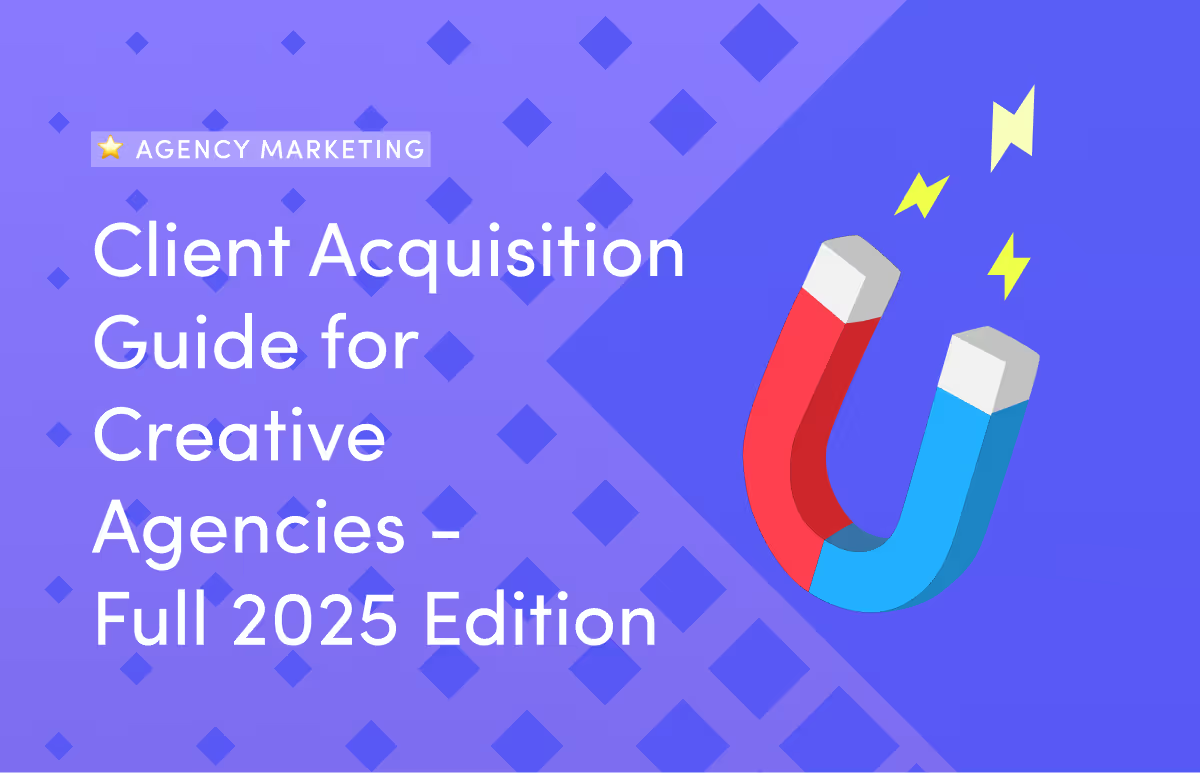Client Acquisition Guide for Creative Agencies - Full 2025 Edition
Your complete client acquisition guide for creative agencies—packed with strategies, tools, and tips to win and retain high-value clients in 2025.




Your creative agency needs clients who value your services and are ready to pay for them. But you need to be able to land clients, retain them, and make them stay.
You already manage client relationships, client projects, market your business, and getting new clients shouldn't add to that struggle.
In this client acquisition guide, I'll break down client acquisition for creative agencies. You'll learn;
The difference between thriving creative agencies and struggling ones is their customer acquisition strategies.
Your marketing strategy should focus on four parts: your unique value proposition, your ideal clients, your website, and your marketing channels.
.avif)
Let's discuss these four pillars:
There are too many agencies doing the same thing. With a bit of difference.
You don't need to create something entirely new, but you need to find ways to differentiate your services so you can stand out from the competition and show the unique value of working with your agency.
A unique value proposition tells clients why they should hire your agency instead of competitors.
Let's look at how Pentagram does it.
They tell potential clients they are “the only major design company where the owners of the business are the creators of the work and are the primary contact for every client”.

Potential clients who value experience and expertise will prefer Pentagram over some random design studio that promises to help improve their website design.
And also, most agency owners are not doing the work by themselves anymore— they outsource. So, clients who believe working directly with agency owners will likely choose Pentagram over others.
So, how do you find a unique value proposition?
Find a niche that works for you. Instead of offering 5-6 services that cater to many personas, stick to one thing that people often ask for. Or a specific service that is hard to execute but has a lot of returns.
Take Hatchly, an on-demand design service in the UK, for example:
He focused on UK small and medium businesses. Then he created one clear offer: "On-demand design service for a flat monthly rate."
This means the customer can ask for as many design as they need for a flat monthly fee.

Hatchly solves a specific problem: Small UK businesses that need professional designs but can't afford full-time designers. Their monthly subscription makes design work predictable and affordable.
How do you do this? It simple;
Your core offering is your flagship service. For Hatchly, it's "Graphic design for a flat monthly fee."
Clients get design work on demand. No hiring designers. No contracts. No surprises.
The math is simple:
Together, these create Hatchly's value proposition: Professional design work without the traditional agency hassle.
Not everyone needs your services— you need to identify who does. You can do that in two steps:
A client persona is a detailed profile of your ideal customer that captures who they are, what they need, their industry, geography, where they hang out online, their goals, and even how they make buying decisions.
For example, Hatchly's ideal client could be:
To build your client persona:
Reach out to people who fit your ideal client description and say “Hi, I launched a new service. I am looking for feedback on my proposition and phrasing. In exchange, I'll make one free design for you."
If they agree to get on a call or meeting with you, ask them questions like:
Pay attention to the words they use in describing their problems; you can use them in your marketing copy, website and in emails).
Find where your clients ask questions so you can read their pain points and know how to sell the solution to them. Some of these communities include:
Your clients take specific steps before they buy from you. First, they recognize their problem. Then, they research solutions. Finally, they purchase what works for them.

A good way is to visualise your client journey as a funnel with these stages: Awareness, consideration, decision, and loyalty.
Your clients go through three stages before they buy from you, and one after they buy your service. You need different marketing approaches for each stage.
At the awareness stage, clients realize they have a problem. They search Google, read blog posts, ask in communities, or read random posts on social media to understand their problem better. You help them by creating educational content about their problems.
During consideration, clients compare solutions. They download guides, attend webinars, and read case studies. You show them how your service solves their problems through your content.
In the decision stage, clients choose their solution. They want product demos, free trials, and consultations. You demonstrate why your service works best for them, and include CTAs that bring them to your door.
The loyalty stage keeps clients with you. You send helpful newsletters, exclusive content, and special offers. These also make clients recommend you to others.
Your website is the first place potential clients will look—it's where all your information will be, so it's important that it communicates your value proposition, shows they can trust you, and converts them to customers.
To do this, your website must answer these questions:
Tell visitors exactly how you can help them. For example, "We help small business owners get paid faster with automated invoicing."
Break down your process in clear steps. For example, “Connect your bank, create invoice templates, and send invoices in 3 clicks."
Show real results from current clients. Add case studies, testimonials, and data that prove your solution works. Example: "Our clients get paid 70% faster — see how XYZ agency collected $50,000 in overdue invoices."
Put this information on your homepage where visitors see it first—it'll help them decide if you're the right fit faster.
Here's an example from our home page:

Our heading goes straight to what we offer: client portal software built for creative agents.
In case users need more context, we broke our processes down. So now they know ManyRequests helps creative agencies manage clients, projects and payments in one easy-to-use platform under their own brand—it's amazing, I know.

We also show social proof with client testimonials and logos of some of the agencies who use our software.
In your case, you can add video testimonials and a portfolio of your work to your website.
Lastly, design your website for micro conversions. These are the conversions that pull potential clients in enough to make them want to purchase your services.
Now, how?
Create a lead magnet that can prompt your visitors to buy your services. For context, it could involve signing up for a free ebook, a quick video demo of your process and offerings, a free 15-minute strategy call, or a quiz/questionnaire that your leads have to fill out.
Once you've got those email subscribers or appointments, you can then aim to convert them into clients for your agency.
Your goal is to find marketing channels that bring you leads at a profit. To do this, you need to test different approaches to see what works for your agency.
Start with one channel. Run a small test for 30 days. Track your results. When you find a channel that brings good leads, focus your time and money there. Scale what works instead of trying everything at once.
Some of the channels you should consider include:
Connect with prospects on LinkedIn or email. Ask questions about their business instead of selling. Example: "How do you handle your design work now?" Build relationships first, then sell later.
Join Slack communities, Facebook feed, or Twitter groups. Share tips, ask questions, and answer questions that can help solve people's problems. You can connect to these people because they may need your services.
Deliver great work and ask clients to refer you. If you like, you can offer them incentives for referrals that convert.
Create content that solves your target clients' problems. It can be SEO-focused blog posts, YouTube tutorials, newsletters, or guest posting on industry websites.
Build your personal brand online so people know the personality behind your business and can easily trust you.
An example is Neil Patel, who co-founded Neil Patel Digital and founded Ubersuggest but is still widely recognized as Neil Patel because he built a perfect personal brand.

How? Give insights and tips where your audience hangs out— X (formerly Twitter), Linkedin, forums, etc…, appear in podcasts, grow your own community.
Here's an example from Dofollow 5000+ members community:

List your service on Clutch, G2, or industry-specific platforms. Encourage your clients to drop reviews to help you rank higher.
Create free templates, calculators, or resources that attract your ideal clients.
Run ads to retarget your website visitors or drive awareness. You can create ads, like testimonials / reviews, examples of past work, or a video of you introducing your service— whatever works for you.
Pick one channel that matches your skills and clients. Test it for 3 months before trying another.
Agencies don't acquire clients like a typical business, but you already know that. Here are six tools you can use to get clients to your agency:
ManyRequests is a client portal and project management software that helps creative agencies handle client onboarding, communication, and project management all in one platform.

ManyRequests lets you create a professional service catalog where you package and sell your creative services, either as one-off projects or recurring subscriptions.

Each service will include a detailed description, pricing, and customizable intake forms to capture project requirements.
You can create a dedicated landing page for each service on your website, and include embedded forms that lets prospective clients sign up directly on the portal. You can also share them as links on your social media pages or through emails.
Once your clients have chosen and paid for a service, you can onboard directly to the platform where they cab:

LinkedIn Premium lets you unlock advanced sales prospecting features that show you potential clients who are more likely to convert. With LinkedIn Premium version, you get access to:
Email scraping tools, such as Apollo.io and Hunter.io, automatically collect email addresses from websites, social media profiles, and other online sources.
They can help you;
However, there's a thin line between legal and illegal email scraping, so make sure you;

HubSpot CRM gives you one central place to store and manage your client information. You can track everything about potential clients and clients, including:
The CRM follows your sales process from start to finish. You see exactly where each lead stands, from the moment they show interest to when they sign with you.

Calendly is a scheduling software that agencies can use to book appointments and meetings with new clients. You can share Calendly links with new clients to know your availability and book a time slot.
Before they book, you can use the form to ask questions about their business goals and budget. Once it's answered, Calendly adds the meeting to your calendar and sends confirmations to both parties.
Other tools you should consider are:
ManyRequests also integrates with Zapier, so you can do all of these things from one platform.
Building a successful creative agency heavily depends on how you find and retain high-value clients. The tips we discussed focus on how creative agencies like yours attract and convert potential clients. We also recommend tools that can make client management easier.
One of our top recommendations is ManyRequests. With ManyRequests, you package your services, onboard clients to your branded portal, and manage everything from projects to payments in one place.
Sign up for a 14-day free trial to see how it works.
Originally Posted: March 2, 2021